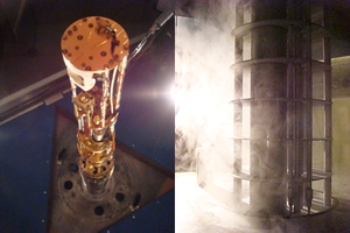A research team from the Laboratory for Atomic and Solid State Physics at Cornell University has succeeded in determining the effect of altering a “heavy fermion” compound’s electronic structure.
The heavy fermion compound comprises ruthenium, silicon and uranium. This discovery provides insight into superconductivity. It was discovered that at increased temperatures, magnetism affects superconductivity negatively while at low temperatures in bulky fermion materials, magnetic atoms are essential.
 Left: A view from below of the experimental probe, with the vacuum can removed.Right: The sealed probe, which includes the STM head and other refrigeration.Courtesy: M.Hamidian
Left: A view from below of the experimental probe, with the vacuum can removed.Right: The sealed probe, which includes the STM head and other refrigeration.Courtesy: M.Hamidian
Researcher Mohammad Hamidian stated that the removal of magnetic atoms decreased the flow of electrons. This is significant, since if it can be proved that superconductivity co-exists with magnetism, it is possible to develop high-temperature superconductors, he added
A scanning microscope was altered by researchers to enable measurement of the force required for pulling and pushing the electrons. Hamidian explained that by doing so, they were able to study the electronic structure of the material comprehensively. The structure was then mapped over a large area to enable viewing changes in those electronic states that occur due to quantum-mechanical reasons. The most critical finding of this research was the capability to view the force of the interactions that render the electrons heavy at the atomic scale.
The Proceedings of the National Academy of Science (PNAS) have presented the Cornell experiment and the results obtained. J.C. Séamus Davis who developed the SI-STM method and a member of the Kavli Institute for Nanoscale Science at Cornell University was a part of the research team. Andrew R. Schmidt, a post-doctoral fellow at UC Berkeley in Physics and formerly student of the Davis at Cornell University and Hamidian, a post doctoral fellow in the Davis research group designed the experiment. The synthesized samples used for the experiment were created by Graeme Luke from McMaster University (Canada).